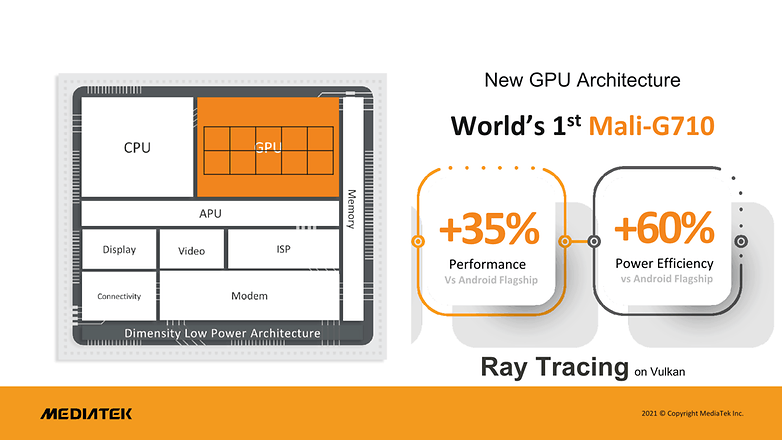MediaTek announces the first 4 nm chip: Dimensity 9000 5G


MediaTek has announced its newest processor, the Dimensity 9000. Although the Taiwanese manufacturer highlights the fact that the chip is the first in the world - publicly announced - to be produced in the "4 nm" process, perhaps the biggest highlight is that it uses the new ARM Cortex-X2 CPU cores with high performance and the first compatible with the new ARMv9 architecture.
TL;DR
- Dimensity 9000 is the first SoC announced in 4 nm, before Apple, Qualcomm, Samsung and others.
- Processor is first announced with new high-performance Cortex-X2 CPUs.
- MediaTek promises a 35% performance jump over current "flagship Android".
- Processor presentation slides highlight several "firsts".
While usually, all eyes are on Qualcomm and Samsung with their Snapdragon and Exynos processors, respectively, MediaTek has slowly been stealing the spotlight. Becoming the largest supplier of smartphone SoCs over 2021 was not enough, now the company can boast of debuting new manufacturing processes, cores and CPU architectures.
- Read also: Complete guide to smartphone processors
Traditionally, the Taiwanese company was the typical "follower of the leaders," adopting mature - and cheap - designs and lithography debuted by the industry leaders, including HiSilicon, a Huawei subsidiary, which was the only one besides Apple to use the TSMC N5 process for a smartphone SoC, while the Snapdragon 888 and Exynos 2100 were released later, manufactured on the Samsung 5LPE process.
4 "nanometers"
The highlighted point of the Dimensity 9000 is exactly the lithography, using the TSMC N4 manufacturing process - popularly known as 4 nm. In addition to the advantages of a smaller footprint, in practice, the biggest leap for consumers is the reduction in power consumption compared to other manufacturing generations, especially in relation to the processes of Samsung Foundry, in general less efficient than those of TSMC.
According to MediaTek, the Dimensity 9000 is up to 37% more efficient than the "Android Flagship," presumably the Snapdragon 888. At the same time, it's up to 35% more powerful in terms of performance, something we're already looking forward to testing.

New generation of ARM CPUs
One of the reasons for the performance jump is the use of ARM's new CPU cores, with the new ARMv9 architecture - another pioneering Dimensity 9000 - for comparison's sake, the previous architecture, ARMv8, was inaugurated in a personal device by Apple, with the iPhone 5S's A7.
MediaTek is the first company to announce an SoC with the new cores, highlighting the high-performance Cortex-X2 coupled with the Cortex-A710 and A510 cores, using a 1+3+4 configuration. The use of the X2 by itself is another first for the manufacturer, which did not get to use the Cortex-X1 CPU - found in the Snapdragon 888, Exynos 2100 and Google Tensor.
Other firsts
As if the previous firsts weren't enough, the Dimensity 9000 is the first SoC announced with support for the new LPPDR5x RAM standard, which promises shorter access time (latency), with a higher data transfer rate. Still, the processor is compatible with the LPDDR5 standard, with higher availability and cheaper.
And just as the processor was the first announced with ARM's new CPU cores, the Dimensity 9000 will also debut the new Mali-G710 GPU. At this point, it's possible that MediaTek will be the only one to adopt the graphics processor, considering that Apple and Qualcomm use proprietary designs, while Samsung is expected to adopt a GPU based on AMD's RDNA2 in its upcoming premium SoCs.

Here the Taiwanese company announces a 35% performance jump over the same "Android Flagship". At this point, however, there is reason for a little skepticism, since MediaTek is usually conservative in the number of graphics cores employed: In the case of the Dimensity 9000 are 10 Mali-G710 GPUs.
Let me explain: the Dimensity 1000/1100/1200 generation uses 9 Mali-G77 cores, while rival flagship chips like the Exynos 2100 and Kirin 9000 employ 14 and 24 cores, respectively, which explains the advantage in games (and benchmarks) of rivals.
With future Exynos adopting AMD GPUs, it's possible that the Dimensity 9000's advantage will disappear before it even hits the market, depending on when the processor is adopted by mobile manufacturers.
Other SoC Blocks
MediaTek also highlighted the new artificial intelligence cores (NPU), 400% faster and 400% more efficient than the previous generation (Dimensity 1200), in addition to the new image processor (ISP) Imagiq 790. Responsible for receiving images from the cameras of the device, the component is now compatible with sensors up to 320 megapixels in resolution, with processing power of up to 9 gigapixels per second, adding the signal from up to three cameras simultaneously.
The video processor, meanwhile, supports 8K resolution video compressed by the new AV1 video format (codec) - but does not yet allow recording to the codec. And for displays, Dimensity 9000 supports high refresh rates up to 180 Hz in FullHD+ and 144 Hz in WQHD+ (1440p+) in anticipation of the popularization of increasingly fluid displays.
Because it's a Dimensity family processor, the 9000 includes MediaTek's own 5G modem, which promises (theoretical) speeds of up to 7 Gbps. As with previous generations, the Dimensity 9000 is not compatible with mmWave frequency bands, which are pretty much only found on carriers in the US and Qualcomm modems (which also equip the iPhones 12 and 13). In addition, the Dimensity is compatible with 6GHz Wi-Fi 6E.

MediaTek Dimensity 9000: Launch and availability
Unveiled on Thursday (18), the Dimensity 9000 is expected to hit shelves equipping mobile phones as early as Q1 2022. As it usually happens in early announcements of mobile chips, the company did not disclose which models should be equipped with the new SoC.
MediaTek's new processor should have strong competition early next year, at which time flagship rivals from Qualcomm (known so far as Snapdragon 898, or 8gen1) and Samsung (Exynos 2200) are also expected. It remains to be seen, not only how the chips compare in terms of performance, but also whether MediaTek will be able to convince mobile manufacturers to adopt the Dimensity 9000.
Moreover, it is possible that some "first-timers" announced by the company will be overturned by rivals, as the next Snapdragon and Exynos are expected with a similar CPU configuration. And in the case of the new Snapdragon, which is expected to be announced at the end of November, it is possible that it will debut as early as 2021, equipping the expected Xiaomi 12.
Question of timing
The Dimensity 9000 has everything to maintain the momentum of MediaTek in the mobile processor market, taking advantage of the company's timing during the popularization of 5G -not only in rich countries, but also in emerging markets - with the launch of next-generation SoCs in price ranges ahead of its rivals.
Furthermore, the manufacturer takes advantage of the diversification of mobile phone brands, with respect to their component suppliers - something that also benefited the almost unknown UniSOC - that filled the void left by Huawei/HiSilicon in the intermediate and premium segments, especially in the Chinese market.
Another point to highlight is the fact that the Taiwanese debuted a manufacturing process from fellow countryman TSMC, while direct rival Qualcomm, had to migrate its top-of-the-line chip for manufacturing at Samsung Foundry, which is less efficient in terms of power consumption and heat dissipation.
More important perhaps than the pioneering spirit is the fact that the company has managed to break Apple's virtual exclusivity on TSMC's most advanced manufacturing processes, responsible for producing the A14, A15 and the M1 family of chips in 5 nm. Meanwhile, video game SoCs, GPUs and other components in high demand continue to use previous-generation processes.
Source: MediaTek
















